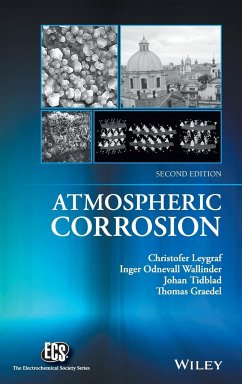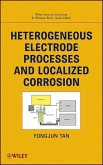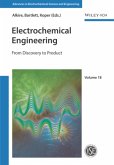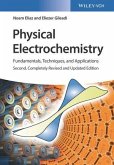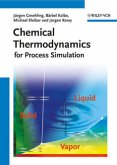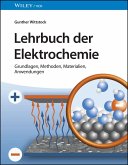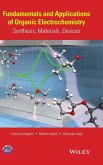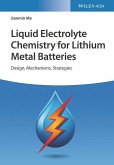- Gebundenes Buch
- Merkliste
- Auf die Merkliste
- Bewerten Bewerten
- Teilen
- Produkt teilen
- Produkterinnerung
- Produkterinnerung
Presents a comprehensive look at atmospheric corrosion, combining expertise in corrosion science and atmospheric chemistry _ Is an invaluable resource for corrosion scientists, corrosion engineers, and anyone interested in the theory and application of Atmospheric Corrosion _ Updates and expands topics covered to include, international exposure programs and the environmental effects of atmospheric corrosion _ Covers basic principles and theory of atmospheric corrosion chemistry as well as corrosion mechanisms in controlled and uncontrolled environments _ Details degradation of materials in…mehr
Andere Kunden interessierten sich auch für
![Heterogeneous Electrode Processes and Localized Corrosion Heterogeneous Electrode Processes and Localized Corrosion]() Yongjun Mike TanHeterogeneous Electrode Processes and Localized Corrosion160,99 €
Yongjun Mike TanHeterogeneous Electrode Processes and Localized Corrosion160,99 €![Electrochemical Engineering / Advances in Electrochemical Science and Engineering Electrochemical Engineering / Advances in Electrochemical Science and Engineering]() Electrochemical Engineering / Advances in Electrochemical Science and Engineering184,51 €
Electrochemical Engineering / Advances in Electrochemical Science and Engineering184,51 €![Physical Electrochemistry Physical Electrochemistry]() Noam EliazPhysical Electrochemistry77,99 €
Noam EliazPhysical Electrochemistry77,99 €![Chemical Thermodynamics Chemical Thermodynamics]() Jürgen GmehlingChemical Thermodynamics77,99 €
Jürgen GmehlingChemical Thermodynamics77,99 €![Lehrbuch der Elektrochemie: Grundlagen, Methoden, Materialien, Anwendungen Lehrbuch der Elektrochemie: Grundlagen, Methoden, Materialien, Anwendungen]() Gunther WittstockLehrbuch der Elektrochemie: Grundlagen, Methoden, Materialien, Anwendungen84,90 €
Gunther WittstockLehrbuch der Elektrochemie: Grundlagen, Methoden, Materialien, Anwendungen84,90 €![Fundamentals and Applications of Organic Electrochemistry Fundamentals and Applications of Organic Electrochemistry]() Toshio FuchigamiFundamentals and Applications of Organic Electrochemistry122,99 €
Toshio FuchigamiFundamentals and Applications of Organic Electrochemistry122,99 €![Liquid Electrolyte Chemistry for Lithium Metal Batteries Liquid Electrolyte Chemistry for Lithium Metal Batteries]() Jianmin MaLiquid Electrolyte Chemistry for Lithium Metal Batteries97,99 €
Jianmin MaLiquid Electrolyte Chemistry for Lithium Metal Batteries97,99 €-
-
-
Presents a comprehensive look at atmospheric corrosion, combining expertise in corrosion science and atmospheric chemistry
_ Is an invaluable resource for corrosion scientists, corrosion engineers, and anyone interested in the theory and application of Atmospheric Corrosion
_ Updates and expands topics covered to include, international exposure programs and the environmental effects of atmospheric corrosion
_ Covers basic principles and theory of atmospheric corrosion chemistry as well as corrosion mechanisms in controlled and uncontrolled environments
_ Details degradation of materials in architectural and structural applications, electronic devices, and cultural artifacts
_ Includes appendices with data on specific materials, experimental techniques, atmospheric species
Hinweis: Dieser Artikel kann nur an eine deutsche Lieferadresse ausgeliefert werden.
_ Is an invaluable resource for corrosion scientists, corrosion engineers, and anyone interested in the theory and application of Atmospheric Corrosion
_ Updates and expands topics covered to include, international exposure programs and the environmental effects of atmospheric corrosion
_ Covers basic principles and theory of atmospheric corrosion chemistry as well as corrosion mechanisms in controlled and uncontrolled environments
_ Details degradation of materials in architectural and structural applications, electronic devices, and cultural artifacts
_ Includes appendices with data on specific materials, experimental techniques, atmospheric species
Hinweis: Dieser Artikel kann nur an eine deutsche Lieferadresse ausgeliefert werden.
Produktdetails
- Produktdetails
- Electrochemical Society Series
- Verlag: Wiley / Wiley & Sons
- Artikelnr. des Verlages: 1W118762270
- 2. Aufl.
- Seitenzahl: 400
- Erscheinungstermin: 5. Juli 2016
- Englisch
- Abmessung: 240mm x 161mm x 26mm
- Gewicht: 694g
- ISBN-13: 9781118762271
- ISBN-10: 1118762274
- Artikelnr.: 44735900
- Herstellerkennzeichnung
- Libri GmbH
- Europaallee 1
- 36244 Bad Hersfeld
- gpsr@libri.de
- Electrochemical Society Series
- Verlag: Wiley / Wiley & Sons
- Artikelnr. des Verlages: 1W118762270
- 2. Aufl.
- Seitenzahl: 400
- Erscheinungstermin: 5. Juli 2016
- Englisch
- Abmessung: 240mm x 161mm x 26mm
- Gewicht: 694g
- ISBN-13: 9781118762271
- ISBN-10: 1118762274
- Artikelnr.: 44735900
- Herstellerkennzeichnung
- Libri GmbH
- Europaallee 1
- 36244 Bad Hersfeld
- gpsr@libri.de
Christofer Leygraf is Professor Emeritus at KTH Royal Institute of Technology, Division of Surface and Corrosion Science, Stockholm, Sweden. Inger Odnevall Wallinder is Professor at KTH Royal Institute of Technology, Division of Surface and Corrosion Science, Stockholm, Sweden. Johan Tidblad is Manager for the Section Corrosion Protection and Surface Technology at Swerea KIMAB, Stockholm, Sweden. Thomas Graedel is Professor Emeritus at Yale School of Forestry and Environmental Studies, New Haven, Connecticut, USA.
Preface xv
1 The Many Faces of Atmospheric Corrosion 1
1.1 Dr. Vernon's Legacy 1
1.2 Concepts and Consequences 2
1.3 The Evolution of a Field 3
1.4 Controlled Laboratory Environments 4
1.5 Uncontrolled Field Environments 5
1.6 New Approaches to Atmospheric Corrosion Studies 6
1.7 An Overview of this Book 6
2 A Conceptual Picture of Atmospheric Corrosion 7
2.1 Introduction 7
2.2 Initial Stages of Atmospheric Corrosion 7
2.3 Intermediate Stages of Atmospheric Corrosion 11
2.4 Final Stages of Atmospheric Corrosion 17
Further Reading 20
3 A Multiregime Perspective on Atmospheric Corrosion Chemistry 22
3.1 Introduction to Moist-Layer Chemistry 22
3.2 The Gaseous Regime 24
3.3 The Interface Regime 25
3.4 The Liquid Regime 27
3.5 The Deposition Regime 28
3.6 The Electrodic Regime 30
3.7 The Solid Regime 31
3.8 The Multiregime Perspective 32
Further Reading 32
4 Atmospheric Gases and their Involvement in Corrosion 34
4.1 Chemical Species of Interest 34
4.2 Atmospheric Corrosive Gases 35
4.3 Historic Trends in Atmospheric Corrosive Gas Concentrations 40
4.4 Predicted Future Emissions of Corrosive Species 43
Further Reading 45
5 Atmospheric Particles and their Involvement in Corrosion 46
5.1 Introduction 46
5.2 Chemical Species of Interest 49
5.3 Sources of Atmospheric Aerosol Particles 50
5.4 Aerosol Particle Physics and Chemistry 51
5.5 Implications of Aerosol Particles for Atmospheric Corrosion 55
Further Reading 57
6 Corrosion in Laboratory Exposures 59
6.1 The Need for Well-Defined Laboratory Experiments 59
6.2 Considerations for Specific Metals 59
6.3 Design Considerations 60
6.4 Examples of Important Laboratory Exposures 65
6.5 Can Corrosion Processes in the Field be Reasonably Simulated by Laboratory Experiments? 67
6.6 Computational Model Studies of SO2-Induced Atmospheric Corrosion of Copper 70
6.7 Summary 76
Further Reading 77
7 Corrosion in Indoor Exposures 79
7.1 General Characteristics of Indoor Environments 79
7.2 The Interplay Between Pollutants and Corrosion Rates 85
7.3 Corrosion Rates 88
7.4 Indoor Corrosion Products 93
7.5 Indoor Environmental Classification 94
7.6 An Example of Indoor Corrosion: Metal Artifacts 95
7.7 Summary 98
Further Reading 99
8 Corrosion in Outdoor Exposures 100
8.1 The Effect of Exposure Conditions 100
8.2 Design Considerations 101
8.3 Influence of Exposure Parameters 103
8.4 Dose-Response Functions 114
8.5 Summary 118
Further Reading 118
9 Advanced Stages of Corrosion 121
9.1 Introduction 121
9.2 Evolution of Corrosion Products on Zinc 122
9.4 Evolution of Corrosion Products on Carbon Steel 140
9.5 Evolution of Corrosion Products on Aluminum 144
9.6 Summary 146
Further Reading 148
10 Environmental Dispersion of Metals From Corroded Outdoor Constructions 151
10.1 Introduction 151
10.2 Metal Dispersion (Runoff): Atmospheric Corrosion 152
10.3 Time-Dependent Aspects and Importance of Rain and Environmental Conditions 154
10.4 Influence of Construction Geometry on the Metal Runoff and Runoff Rate Predictions 159
10.5 Environmental Fate and
1 The Many Faces of Atmospheric Corrosion 1
1.1 Dr. Vernon's Legacy 1
1.2 Concepts and Consequences 2
1.3 The Evolution of a Field 3
1.4 Controlled Laboratory Environments 4
1.5 Uncontrolled Field Environments 5
1.6 New Approaches to Atmospheric Corrosion Studies 6
1.7 An Overview of this Book 6
2 A Conceptual Picture of Atmospheric Corrosion 7
2.1 Introduction 7
2.2 Initial Stages of Atmospheric Corrosion 7
2.3 Intermediate Stages of Atmospheric Corrosion 11
2.4 Final Stages of Atmospheric Corrosion 17
Further Reading 20
3 A Multiregime Perspective on Atmospheric Corrosion Chemistry 22
3.1 Introduction to Moist-Layer Chemistry 22
3.2 The Gaseous Regime 24
3.3 The Interface Regime 25
3.4 The Liquid Regime 27
3.5 The Deposition Regime 28
3.6 The Electrodic Regime 30
3.7 The Solid Regime 31
3.8 The Multiregime Perspective 32
Further Reading 32
4 Atmospheric Gases and their Involvement in Corrosion 34
4.1 Chemical Species of Interest 34
4.2 Atmospheric Corrosive Gases 35
4.3 Historic Trends in Atmospheric Corrosive Gas Concentrations 40
4.4 Predicted Future Emissions of Corrosive Species 43
Further Reading 45
5 Atmospheric Particles and their Involvement in Corrosion 46
5.1 Introduction 46
5.2 Chemical Species of Interest 49
5.3 Sources of Atmospheric Aerosol Particles 50
5.4 Aerosol Particle Physics and Chemistry 51
5.5 Implications of Aerosol Particles for Atmospheric Corrosion 55
Further Reading 57
6 Corrosion in Laboratory Exposures 59
6.1 The Need for Well-Defined Laboratory Experiments 59
6.2 Considerations for Specific Metals 59
6.3 Design Considerations 60
6.4 Examples of Important Laboratory Exposures 65
6.5 Can Corrosion Processes in the Field be Reasonably Simulated by Laboratory Experiments? 67
6.6 Computational Model Studies of SO2-Induced Atmospheric Corrosion of Copper 70
6.7 Summary 76
Further Reading 77
7 Corrosion in Indoor Exposures 79
7.1 General Characteristics of Indoor Environments 79
7.2 The Interplay Between Pollutants and Corrosion Rates 85
7.3 Corrosion Rates 88
7.4 Indoor Corrosion Products 93
7.5 Indoor Environmental Classification 94
7.6 An Example of Indoor Corrosion: Metal Artifacts 95
7.7 Summary 98
Further Reading 99
8 Corrosion in Outdoor Exposures 100
8.1 The Effect of Exposure Conditions 100
8.2 Design Considerations 101
8.3 Influence of Exposure Parameters 103
8.4 Dose-Response Functions 114
8.5 Summary 118
Further Reading 118
9 Advanced Stages of Corrosion 121
9.1 Introduction 121
9.2 Evolution of Corrosion Products on Zinc 122
9.4 Evolution of Corrosion Products on Carbon Steel 140
9.5 Evolution of Corrosion Products on Aluminum 144
9.6 Summary 146
Further Reading 148
10 Environmental Dispersion of Metals From Corroded Outdoor Constructions 151
10.1 Introduction 151
10.2 Metal Dispersion (Runoff): Atmospheric Corrosion 152
10.3 Time-Dependent Aspects and Importance of Rain and Environmental Conditions 154
10.4 Influence of Construction Geometry on the Metal Runoff and Runoff Rate Predictions 159
10.5 Environmental Fate and
Preface xv
1 The Many Faces of Atmospheric Corrosion 1
1.1 Dr. Vernon's Legacy 1
1.2 Concepts and Consequences 2
1.3 The Evolution of a Field 3
1.4 Controlled Laboratory Environments 4
1.5 Uncontrolled Field Environments 5
1.6 New Approaches to Atmospheric Corrosion Studies 6
1.7 An Overview of this Book 6
2 A Conceptual Picture of Atmospheric Corrosion 7
2.1 Introduction 7
2.2 Initial Stages of Atmospheric Corrosion 7
2.3 Intermediate Stages of Atmospheric Corrosion 11
2.4 Final Stages of Atmospheric Corrosion 17
Further Reading 20
3 A Multiregime Perspective on Atmospheric Corrosion Chemistry 22
3.1 Introduction to Moist-Layer Chemistry 22
3.2 The Gaseous Regime 24
3.3 The Interface Regime 25
3.4 The Liquid Regime 27
3.5 The Deposition Regime 28
3.6 The Electrodic Regime 30
3.7 The Solid Regime 31
3.8 The Multiregime Perspective 32
Further Reading 32
4 Atmospheric Gases and their Involvement in Corrosion 34
4.1 Chemical Species of Interest 34
4.2 Atmospheric Corrosive Gases 35
4.3 Historic Trends in Atmospheric Corrosive Gas Concentrations 40
4.4 Predicted Future Emissions of Corrosive Species 43
Further Reading 45
5 Atmospheric Particles and their Involvement in Corrosion 46
5.1 Introduction 46
5.2 Chemical Species of Interest 49
5.3 Sources of Atmospheric Aerosol Particles 50
5.4 Aerosol Particle Physics and Chemistry 51
5.5 Implications of Aerosol Particles for Atmospheric Corrosion 55
Further Reading 57
6 Corrosion in Laboratory Exposures 59
6.1 The Need for Well-Defined Laboratory Experiments 59
6.2 Considerations for Specific Metals 59
6.3 Design Considerations 60
6.4 Examples of Important Laboratory Exposures 65
6.5 Can Corrosion Processes in the Field be Reasonably Simulated by Laboratory Experiments? 67
6.6 Computational Model Studies of SO2-Induced Atmospheric Corrosion of Copper 70
6.7 Summary 76
Further Reading 77
7 Corrosion in Indoor Exposures 79
7.1 General Characteristics of Indoor Environments 79
7.2 The Interplay Between Pollutants and Corrosion Rates 85
7.3 Corrosion Rates 88
7.4 Indoor Corrosion Products 93
7.5 Indoor Environmental Classification 94
7.6 An Example of Indoor Corrosion: Metal Artifacts 95
7.7 Summary 98
Further Reading 99
8 Corrosion in Outdoor Exposures 100
8.1 The Effect of Exposure Conditions 100
8.2 Design Considerations 101
8.3 Influence of Exposure Parameters 103
8.4 Dose-Response Functions 114
8.5 Summary 118
Further Reading 118
9 Advanced Stages of Corrosion 121
9.1 Introduction 121
9.2 Evolution of Corrosion Products on Zinc 122
9.4 Evolution of Corrosion Products on Carbon Steel 140
9.5 Evolution of Corrosion Products on Aluminum 144
9.6 Summary 146
Further Reading 148
10 Environmental Dispersion of Metals From Corroded Outdoor Constructions 151
10.1 Introduction 151
10.2 Metal Dispersion (Runoff): Atmospheric Corrosion 152
10.3 Time-Dependent Aspects and Importance of Rain and Environmental Conditions 154
10.4 Influence of Construction Geometry on the Metal Runoff and Runoff Rate Predictions 159
10.5 Environmental Fate and
1 The Many Faces of Atmospheric Corrosion 1
1.1 Dr. Vernon's Legacy 1
1.2 Concepts and Consequences 2
1.3 The Evolution of a Field 3
1.4 Controlled Laboratory Environments 4
1.5 Uncontrolled Field Environments 5
1.6 New Approaches to Atmospheric Corrosion Studies 6
1.7 An Overview of this Book 6
2 A Conceptual Picture of Atmospheric Corrosion 7
2.1 Introduction 7
2.2 Initial Stages of Atmospheric Corrosion 7
2.3 Intermediate Stages of Atmospheric Corrosion 11
2.4 Final Stages of Atmospheric Corrosion 17
Further Reading 20
3 A Multiregime Perspective on Atmospheric Corrosion Chemistry 22
3.1 Introduction to Moist-Layer Chemistry 22
3.2 The Gaseous Regime 24
3.3 The Interface Regime 25
3.4 The Liquid Regime 27
3.5 The Deposition Regime 28
3.6 The Electrodic Regime 30
3.7 The Solid Regime 31
3.8 The Multiregime Perspective 32
Further Reading 32
4 Atmospheric Gases and their Involvement in Corrosion 34
4.1 Chemical Species of Interest 34
4.2 Atmospheric Corrosive Gases 35
4.3 Historic Trends in Atmospheric Corrosive Gas Concentrations 40
4.4 Predicted Future Emissions of Corrosive Species 43
Further Reading 45
5 Atmospheric Particles and their Involvement in Corrosion 46
5.1 Introduction 46
5.2 Chemical Species of Interest 49
5.3 Sources of Atmospheric Aerosol Particles 50
5.4 Aerosol Particle Physics and Chemistry 51
5.5 Implications of Aerosol Particles for Atmospheric Corrosion 55
Further Reading 57
6 Corrosion in Laboratory Exposures 59
6.1 The Need for Well-Defined Laboratory Experiments 59
6.2 Considerations for Specific Metals 59
6.3 Design Considerations 60
6.4 Examples of Important Laboratory Exposures 65
6.5 Can Corrosion Processes in the Field be Reasonably Simulated by Laboratory Experiments? 67
6.6 Computational Model Studies of SO2-Induced Atmospheric Corrosion of Copper 70
6.7 Summary 76
Further Reading 77
7 Corrosion in Indoor Exposures 79
7.1 General Characteristics of Indoor Environments 79
7.2 The Interplay Between Pollutants and Corrosion Rates 85
7.3 Corrosion Rates 88
7.4 Indoor Corrosion Products 93
7.5 Indoor Environmental Classification 94
7.6 An Example of Indoor Corrosion: Metal Artifacts 95
7.7 Summary 98
Further Reading 99
8 Corrosion in Outdoor Exposures 100
8.1 The Effect of Exposure Conditions 100
8.2 Design Considerations 101
8.3 Influence of Exposure Parameters 103
8.4 Dose-Response Functions 114
8.5 Summary 118
Further Reading 118
9 Advanced Stages of Corrosion 121
9.1 Introduction 121
9.2 Evolution of Corrosion Products on Zinc 122
9.4 Evolution of Corrosion Products on Carbon Steel 140
9.5 Evolution of Corrosion Products on Aluminum 144
9.6 Summary 146
Further Reading 148
10 Environmental Dispersion of Metals From Corroded Outdoor Constructions 151
10.1 Introduction 151
10.2 Metal Dispersion (Runoff): Atmospheric Corrosion 152
10.3 Time-Dependent Aspects and Importance of Rain and Environmental Conditions 154
10.4 Influence of Construction Geometry on the Metal Runoff and Runoff Rate Predictions 159
10.5 Environmental Fate and

